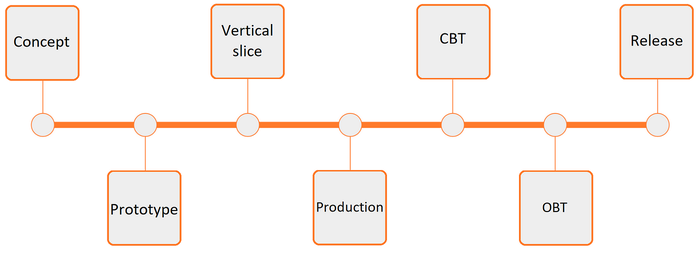During game development, we’re a little in the dark about how players might experience and respond to the projects we’re working on. That’s where UX research comes into play to help cast a light in the darkness — so we can look before we leap and make measured decisions up front, rather than unexpected reactions later. At the same time, if something isn’t going as expected UX research can help us to right the ship and get back on track.
Hello everyone, we are Maria Amirkhanyan and Anna Dedyukhina, we are UX researchers at MY.GAMES. In this article, we’ll talk about why UX research should be carried out in game development, the benefits it holds, how conducting it differs at various stages of development, explain in detail the research methods generally used, and we’ll describe a number of cases where these approaches have been applied. In MY.GAMES we’re driven by product success, and our focus is on creating games that become leaders within their categories. UX research helps us achieve this — the results of the research allow us to improve the user experience, respond to the needs of our audience and solve problems quickly.
Defining UX
To properly understand UX research, we’ll first need to define UX itself. UX, or “User Experience” is the complete experience a user has when interacting with a product. In the realm of video games, players are the users, and the game is the product.
UX is often discussed in tandem with UI (User Interface), but UX is actually a broader concept: UI primarily concerns the interface, while UX involves core gameplay, meta gameplay, all the mechanics, setting, the conceptual goal of a game, the complexity of the game, and so on — in general, absolutely everything with which the player can interact.
As hinted, UX touches a large number of gameplay aspects: the convenience of gameplay and interface, an understanding the rules of the game, the difficulty curve, intuitive sense of control, and much more. Further, each of these aspects has its own idiosyncrasies for different genres and audiences.

Nice design, but users endure a really bad UX
Why do we conduct UX research?
There are many factors that influence player comfort, and we conduct UX research to try and understand them all.
It’s important to mention that UX research isn’t about detecting and dealing with bugs or anything directly involving the technical components of a game. Instead, UX research is about actual player perception of a game, its mechanics, and interface.
UX research comes in handy during the development process, because, normally, we’d never really know how real players will think, what they would do, or the reasons behind some of their behavior. UX research allows us to make informed development decisions and to save time and money. (After all, it’s more convenient to know in advance how to do things right, instead of later redoing everything a thousand times.)
Additionally, UX research is valuable during the lifecycle of a game. Over time, any game will tend to lose part of its audience. While the most active users will describe their reasons for leaving, some others rarely leave feedback, so we can only guess their motivation for doing so.
The UX research process
Let’s have a brief description of the UX research process:
-
We select a player that matches the target audience of our product.
-
We ask them to play our game the way they usually do. (Otherwise, users tend to test the game and try to “break” it — but we’re interested in their usual behavior).
-
At this point, we observe the player and their emotions. Tracking emotions is difficult, so sometimes we use things like AI to track emotions via facial expressions, or psychophysiological tools like electroencephalography (EEG) or galvanic skin response (GSR) equipment. EEG allows us to more accurately determine emotions and GSR helps identify how tense or excited a player is. But unlike EEG, GSR cannot identify if excitement is positive or not, we might see something, but we find the reason by interviewing players. Sometimes, we’ll also use an eye-tracking system.
-
We request players fill out questionnaires.
-
We ask questions (many questions). We’ll give specific examples in the second article in the series.
-
That’s it, finished!

In this illustration by UX Lab’s Ekaterina Lisovskaya, opossums demonstrate the research process
The benefits of UX research
UX research often allows us to find problems that aren’t obvious to developers. Let’s get specific to illustrate: a good example of such a problem that made it into the final game is the mini-map in Cyberpunk 2077. In the game, the mini-map is too zoomed-in and cannot be zoomed out. When a player is driving to a marker, they often fail to make a turn in time, since the map does not move away during movement. As a result, players crash and get upset. Of course, if you’re looking at the mini-map non-stop, you can compensate for this, but then players would miss all the beauty of Night City.
https://www.youtube.com/watch?v=ZtgnAabn15k
Because of the mini-map, players constantly miss turns; bad physics and pedestrians jumping under the wheels only make the situation worse.
Could this feature have been implemented better? Sure, and it has been. For instance, in GTA V, the map zooms in and out based on whether a player is inside a vehicle or going at it on foot. This allows players to plan and anticipate their movements without any problem, since all turns are easily visible on the mini-map in advance.

In GTA V, the scale of the mini-map changes depending on the speed of transport
In terms of UX, we can steer clear of issues like the aforementioned Cyberpunk 2077 mini-map quirk by following a few rules during the development stage:
-
Meticulously observing player behavior
-
Taking into account the original purpose of a mechanic
-
Keeping in mind the kind of behavior we expect from players
-
Checking if the game provides the necessary conditions for a player to be able to perform the desired actions
This problem could’ve been avoided if the developers had done a competent UX study — but they probably didn’t. There are various reasons for this: perhaps there was not enough time, not enough budget, other problems were prioritized instead, or they didn’t have time to fix neither technical problems, nor UX problems.
UX research at different stages of game development
In the gaming world, the development timeline usually looks like this:

During each of these stages, we can conduct UX research, although the form it takes can be different depending on the point a project is at in the timeline. Let’s take a look at each of the stages above in terms of conducting UX research.
Concept. Any product begins development with an idea and a concept. We think about the genre, the content, what we expect from the game, and we also create documentation, prepare art, and take into account the type of monetization.
At this early stage can we already be researching something? Yes! We can test our hypotheses about the audience, and study this (what players like or dislike). It’s possible to decide which features should be added to the game (and which shouldn’t). We could also choose a setting, and try to understand whether our target audience will like it (for example, casual players are unlikely to be happy with the gloomy setting of Darkest Dungeons).
Prototype. Prior to this stage, perhaps we could only “chat” with players and discuss ideas, but with the help of a prototype, users can actually try features out. Moreover, you can give them a task to see how they’ll solve it, for example, “Let’s say you need to upgrade your character, how would you do it?”.
With a more developed visualization, it will be easier for a potential player to imagine a feature. The better testers understand how a feature works, the more reliable the results of the study. At this stage, we continue to test our ideas, discuss what we want to add (and in what format), and judge if we’re moving in the right direction.
Vertical Slice. Finally, the project is playable with some typical gameplay! This is the “golden stage”. We can collect feedback from our vertical slice, understand what the gameplay feels like, how features function, the convenient and inconvenient things for players, and so on. At this time, we’ll also start active game playtests.
Production. This is the longest stage of development. Levels and locations are added and the world is developing. And this all can (and should) be tested. Of course, if you ‘ve added just one small detail, this is probably not a good enough reason for running testing, but big things are definitely worth checking out with players. You can test some features locally or run quarterly large tests during this development phase.
Closed and open beta tests. By this time, the game has a lot of content and only requires polishing. You can finally give game access to a large number of users. We’ll combine our methods: we conduct detailed tests with some players, while others play on their own, then fill out a questionnaire. At this stage, you can understand how the audience is evaluating the gameplay, visual appearance, and the game as a whole.
It’s also worth thinking about features according to criteria of importance and implementation quality. For example, if a feature is not good enough, and it’s not particularly important to the players, then you should ask yourself: “Do I need to keep it?”. If a feature is important, but the quality of the implementation is low, then it definitely needs to be worked on first.
Release. It might seem like you can relax after release, but in fact, work is just beginning! Next up is game localization, support, operations, updates, patches, DLC, retention efforts, and so much more.
Gaming UX research methods at a glance
Many of the methods described below will be familiar to those familiar with UX research in general. However, it’s important to note the specifics that distinguish UX research involving video games from banking applications or online stores.
Each of the methods is worthy of a length article of its own, but in this post, we’ll briefly outline each of the main approaches: how to use them, and what to consider whether you’re about to conduct research for the first time, or for the n-th time.
1. Playtesting
Playtests are the main research tool in the gaming context; they allow us to learn about a complete gaming experience, and evaluate both the individual features and the overall impression of a full-fledged product.
As part of a playtest, we invite people to play our project or prototype and ask them to share their impressions. Meanwhile we observe the playtesting process, ask questions, and identify important problems and insights. Unlike a usability test, we don’t interfere with the game process in order to avoid distracting the participant, and we ask our questions after the session or during pauses (for example, while a screen is loading).
Playtests allow you to detect problems with basic mechanics, interfaces, meta gameplay, visual quality and authenticity, general impressions and many speci




































